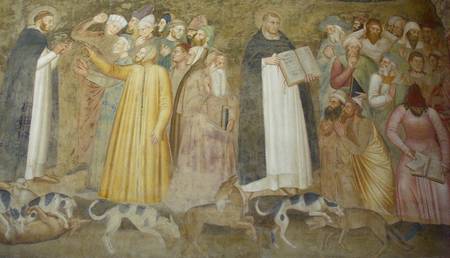An update to Blue Guide Florence from Alta Macadam.
One of the frustrations of guide book writing is the rate at which changes can occur. In the latest edition of Blue Guide Florence I complained that the museum of Santa Maria Novella had “a rather shabby and abandoned feel to it”, and that the oldest part of the monastery had been “closed for restoration for many years”. At that time there seemed no signs at all that the situation would change, and indeed I had found it in the same state for at least the previous four editions!
But now–finally–my complaints are no longer true, since a few months ago the museum arranged around the cloisters attached to the great church of Santa Maria Novella was given a definitive facelift and provided with a brand new entrance from the station square. Most important of all, access into the church from the Green Cloister has been provided so that the two monuments are once again linked together in their correct historical context (and can be visited with a single ticket).
You can now visit the Cloister of the Dead (so named because there was a cemetery here) and the pavement tombs and funerary monuments on the walls are well lit and well cared for (although sadly there is no description of them, as yet: it would be interesting to have the inscriptions and dates transcribed). The mid-14th-century frescoes include those in a chapel attributed to Orcagna (where the unusual Nativity scene is dominated by a flock of sheep and goats, and even a bumptious dog). Although the other frescoes here are extremely worn and some of them now barely visible, they have been restored as far as possible, and excellent explanations are provided in situ of the history of this, the oldest part of the monastery.
In contrast, off the adjoining cloister, the frescoes in the Spanish Chapel, dating from the later 14th century, are superbly preserved, and they remain one of the great sights of Florence. Here, too, the new explanatory panels (also in English), are well placed and extremely helpful. This chapel overlooks the Green Cloister with its three mighty cypress trees, and green-toned frescoes. The four most important lunettes, by Paolo Uccello, have been removed for restoration, but one of the four can always be seen (on a rotating basis–when not in the restoration laboratory) in the Chapter House close by. Here, since they are displayed at ground level, the visitor is provided with a wonderful opportunity to examine them at very close range. The huge vaulted chapter house also provides a magnificent setting for some of the monastery’s treasures, including vestments and church silver, and in the adjoining chapel are two memorable late 14th-century painted wood busts of female saints, as well as an altar frontal with fifteen charming embroidered scenes of the life of the Virgin, stitched by nuns in a Florentine convent in 1466. From outside this chapel glass doors enable you to look into the Great Cloister–currently occupied by the military police, though they are soon to be moved to new barracks, so this part of the monastery will also one day be accessible to the public.

It is extremely encouraging that the Florentine authorities have succeeded in making this monumental area in the heart of the city so inviting a place to visit. On some days it even has an atmosphere which perhaps recalls the days when pilgrims would call in here, as today travellers on their way to and from the railway station (with their luggage sometimes in tow!) can often be seen enjoying the peace of the cloisters as well as the wonderful works of art.






